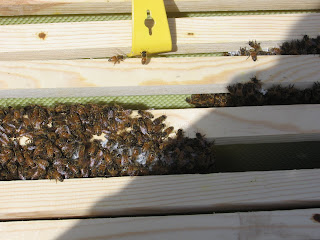Four miles from my house, down the side streets and back streets behind the train station, through old neighborhoods built in the early 1900’s, past signs of houses for sale or in foreclosure, and alongside a small huddle of people waiting for a city bus, I parked near a decrepit, red barn with boarded up doors. The driveway down to the field is still thick with mud after all the winter and spring rains we’ve had. Thankfully, I remembered to throw my muck boots in the back of the car. Larimer Road, which becomes Lowell-Larimer Road another mile or two south, is one of those hard-to-find back country drives through scenic farmland and momentary river views. I think most people don’t even know where it goes anymore. What little noise comes from it faded as I worked my way down the muddy track toward what will be the parking area once things dry out in a few weeks. I was accompanied by robins hopping through the thick blackberry tangles. Smaller birds, and here my lack of bird knowledge will show quite clearly, darted in and out of tall, dry grasses. Far to the east, beyond the border of this ten acre plot, a bird of prey swooped low over the fields looking for an early lunch. The sun warmed me through layers of polar fleece and wool, but it disappeared with the fast moving clouds overhead. A swift wind was whipping its way around the farm. I wondered how seedlings would be able to withstand it. A little further along what was once a roadway, I see stakes marking plots. Most of them have been taken over by wild mustard, chickweed, quack grass, and others I can’t identify. I’ve read that the types of weeds your soil grows will tell you a lot about its fertility. This looks like healthy soil. The demonstration gardens up front, and a second plot further back, are still being used. Kale, broccoli, collards, onions, and some cabbages stand in defiance of the wind. I kept walking back, all the way to the edge of the area that had been plowed up last year. It’s an impressive amount of space. I’m not sure I’ve ever seen ten acres bare and waiting like this. Living in the city, it’s difficult to envision how big an acre is. Ask me how big a three by six raised bed is, and I can show you without a measuring tape. This scale, on the other hand, looks daunting. I turn to look back at the barn by the road, now in the far distance. Welcome to the Red Barn Community Farm.
Red Barn Community Farm is an urban agriculture project in the city of Everett, Washington. It sits on ten acres of Everett-owned prime river bottom soil, of which about two acres have been actively cultivated. The farm is divided into individually farmed plots which are rented, crop share plots worked by groups, food bank plots for the Everett Food Bank, and a demonstration garden. 2012 will be the second year that this land is farmed by the Red Barn Community Farm.
As of the month of March, I have begun an internship with Red Barn Community Farm (which may be referred to as RBCF throughout all related posts). You might already know that I’ve been studying Environmental Planning and Policy through the Huxley College of the Environments at Western Washington University, and this internship will help me satisfy some credits and requirements for that degree. More importantly, however, this opportunity will let me jump into a hands-on urban agriculture project in my own neighborhood. I’ll be chronicling the steps in this journey through blogging, interviewing, and writing reports, and you’re welcome to join me along the way. Yesterday was my first visit to the farm itself. It thrilled me to the very core. This is exactly what I feel I should be doing in the world, and it feels great to express it in actions and words.
My internship will evolve as the seasons progress. For the time being, I will be involved in planning and organizing some aspects of the farm. I’ll show up for work parties and other events that promote RBCF, I’ll create and maintain social media for the farm, and I’ll be looking for local businesses and organizations willing to share labor, materials, and other types of donations to keep us going. I’ll learn about what makes a volunteer-driven organization succeed or fail, and hopefully I’ll figure out how to build a farm like this in any community. During this experience, I’ll also conduct interviews with participants, organizers, and other organizations around the world who are doing similar work.
I’ve spent a lot of time thinking about where I fit in when it comes to my environment, my community, my family, my job, and even my own garden. Deciding to take on an internship of this size is nothing to sneeze at. I started this blog to find a way to write about my experiences as an urban chicken farmer. Somewhere along the way, I realized I needed to do more. Now I find myself in the middle of an intense college education, struggling with a job that doesn’t fit very well anymore, and ready to take on not just a career change but a lifestyle adjustment. This is still just a city chicken farm, but it’s about to grow into something more.





















